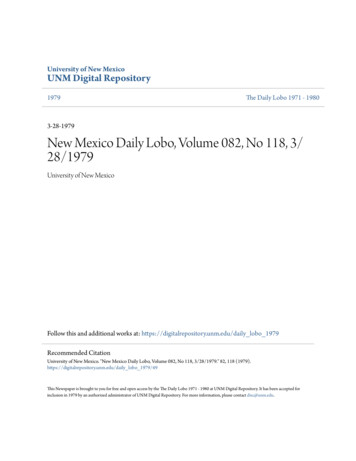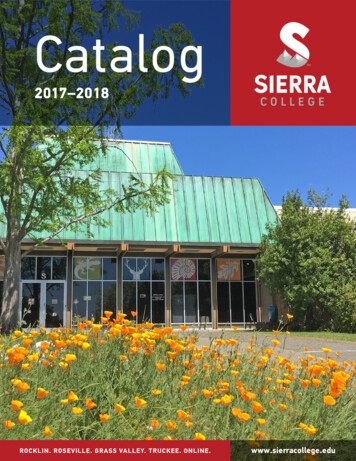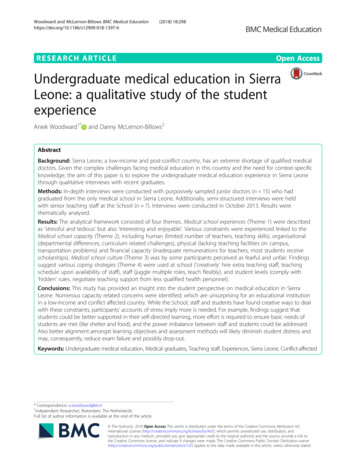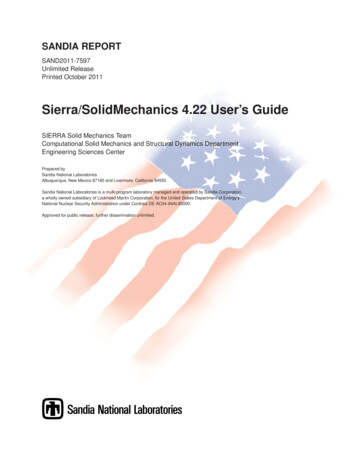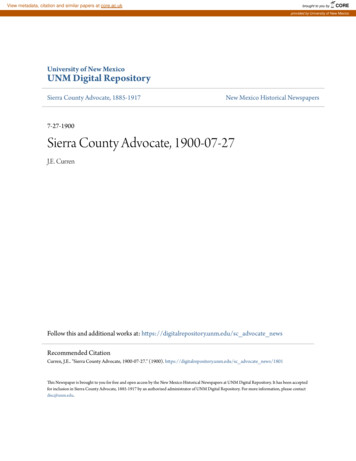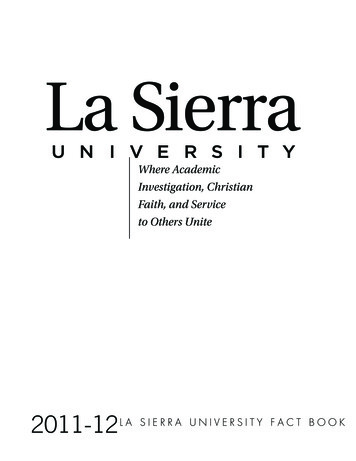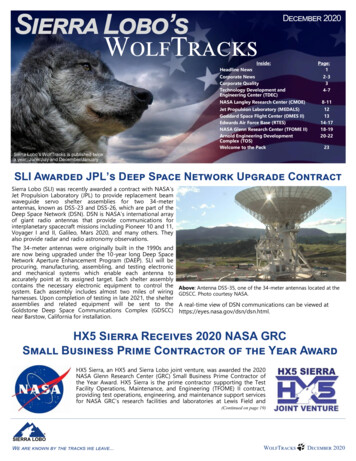
Transcription
Sierra Lobo’sWolfTracksDecember 2020Inside:Page:1Headline NewsCorporate NewsCorporate QualityTechnology Development andEngineering Center (TDEC)2-334-7NASA Langley Research Center (CMOE)8-11Jet Propulsion Laboratory (MEDALS)Goddard Space Flight Center (OMES II)Edwards Air Force Base (RTES)NASA Glenn Research Center (TFOME II)Arnold Engineering DevelopmentComplex (TOS)Welcome to the Pack121314-1718-1920-2223Sierra Lobo’s WolfTracks is published twicea year; June/July and December/January.SLI Awarded JPL’s Deep Space Network Upgrade ContractSierra Lobo (SLI) was recently awarded a contract with NASA’sJet Propulsion Laboratory (JPL) to provide replacement beamwaveguide servo shelter assemblies for two 34-meterantennas, known as DSS-23 and DSS-26, which are part of theDeep Space Network (DSN). DSN is NASA’s international arrayof giant radio antennas that provide communications forinterplanetary spacecraft missions including Pioneer 10 and 11,Voyager I and II, Galileo, Mars 2020, and many others. Theyalso provide radar and radio astronomy observations.The 34-meter antennas were originally built in the 1990s andare now being upgraded under the 10-year long Deep SpaceNetwork Aperture Enhancement Program (DAEP). SLI will beprocuring, manufacturing, assembling, and testing electronicand mechanical systems which enable each antenna toaccurately point at its assigned target. Each shelter assemblycontains the necessary electronic equipment to control thesystem. Each assembly includes almost two miles of wiringharnesses. Upon completion of testing in late 2021, the shelterassemblies and related equipment will be sent to theGoldstone Deep Space Communications Complex (GDSCC)near Barstow, California for installation.(PhoAbove: Antenna DSS-35, one of the 34-meter antennas located at theGDSCC. Photo courtesy NASA.A real-time view of DSN communications can be viewed athttps://eyes.nasa.gov/dsn/dsn.html.HX5 Sierra Receives 2020 NASA GRCSmall Business Prime Contractor of the Year Award(Photo Credit: SLI)HX5 Sierra, an HX5 and Sierra Lobo joint venture, was awarded the 2020NASA Glenn Research Center (GRC) Small Business Prime Contractor ofthe Year Award. HX5 Sierra is the prime contractor supporting the TestFacility Operations, Maintenance, and Engineering (TFOME) II contract,providing test operations, engineering, and maintenance support servicesfor NASA GRC’s research facilities and laboratories at Lewis Field and(Continued on page 19)We are known by the tracks we leave.WolfTracksDecember 2020
Corporate NewsA Note from our Chief Operating Officer, Daniel R. LoweDear Sierra Lobo Team:First and foremost, we would like to thank you for your dedication and contributions duringthese unprecedented times. Our employees and teammate employees are the bedrock for theservices we provide.Since Sierra Lobo, Inc. incorporated in 1993, we have consistently executed growth, building onthe foundation of our vision and focus on customer service excellence, innovation, growth, andrisk management. We continue to grow on this foundation.Sierra Lobo has taken every step to ensure the safety of our employees. We have closelymonitored all State and Federal guidelines regarding the COVID-19 virus. At each of ourcontract locations, we have worked diligently with our Government and teammate customers tokeep everyone safe. Our Corporate Office has also worked diligently to incorporate new policiesand procedures, including: safety and wellness checks, flexible work from home arrangementsand schedules, increased cleaning and sanitation, and implementing COVID-19 related paidleave in compliance with the Families First Coronavirus Response Act (FFCRA). You can viewmany of our efforts at https://COVID-19 Information Page – Sierra Lobo, Inc. I want to thankeveryone for their unrelenting commitment to safety during this unparalleled time. It is duringthese extraordinary times that we truly see what the WolfPack can accomplish when we cometogether.Above: Daniel R. Lowe, ChiefOperating Officer, SLI. (Photocredit: SLI)In this newsletter, we have provided highlights of our products, services, and people. Please feel free to reach out tomanagement or myself with feedback.Sincerely yours,Daniel R. LoweSLI Completes Basic AssessmentAs the DoD continues with the rollout of the Cybersecurity Maturity Model Certification (CMMC), a recently released interimrule created three additional Defense Federal Acquisition Regulation Supplement (DFARS) clauses that supplement the alreadyexisting DFARS 7012 clause.One of these clauses, DFARS 7019, requires contractors in the Defense Industrial Base (DIB) to perform at least a basicassessment against the NIST SP 800-171 controls every three years and to report the score of that assessment in the SupplierPerformance Risk System (SPRS).SLI recently partnered with Helm Point Solutions to perform this assessment. As a result of this basic assessment and theresulting score that was uploaded to SPRS, SLI has been able to meet the requirements of DFARS 7019.As part of the ongoing medium level assessment, we are continuing to work with Helm Point to refine our System Security Plan(SSP) and generate a detailed Plan of Actions and Milestones (POAM) so that there is a clear and defined path to fullcompliance with all NIST SP 800-171 controls.This compliance is the first step in achieving CMMC level 3 certification in the future.We are known by the tracks we leave.2WolfTracksDecember 2020
Corporate QualityJeff’s Quality CornerSafe and Effective Return to On-site WorkFollowing the PandemicAs we proceed into the New Year, there is hope that our worktransition toward returning to work on site at our customer locations.envision this transition being phased over time to gradually loosenCOVID-19 protocols of checking temperatures upon entry toworkplace, wearing face coverings, and social distancing. Some ofprotocols may remain a part of our daily activities for quite some time.willWethetheTo ensure the safety of our staff, we verify all required safety training and certifications are at acurrent status prior to the actual performance of work. Our safety and training professionals haveworked diligently over the past year to maintain our safety training and certifications during thepandemic, but there will be some cases where catch-up will be required. We all want to return toour on-site work locations as quickly as possible, but it is essential to have the required safetytraining and certifications in place prior to performing the work which requires them.Our quality and training professionals have worked to diligently to confirm all required skill andquality training and certifications are up to date prior to performing work. There will also be somecases identified where training and certifications must be brought to current status as well.Above: Jeff Sultzbaugh,Director of MissionAssurance; Contracts andPurchasing, SLI. (Photocredit: SLI)Other areas that may require consideration include those having to do with the physical workspace. Some of us may beassigned to work in areas new to us due to shifting work requirements during the pandemic. In these circumstances, ourmanagers and supervisors ensure employees receive orientation training informing the staff of hazards and countermeasuresspecific to the workplace. Things which come to mind include area warning systems, such as low oxygen alarms, high noiseareas, or the presence of hazardous chemicals.The proper use and care of personal protective equipment (PPE) will remain essential to maintaining safety. Please make sureall issued PPE is in good repair and fully functional or obtain new equipment from your management.In closing, I would like to thank each of our managers, supervisors, safety, quality, training professionals, and each employeefor your steadfast commitment to the safety and quality of the services we provide to our customers. Please accept heartfeltwishes for a safe and effective return to on-site work as this pandemic comes to an end.Corporate NewsBringing Holiday CheerThe holiday season is a happy and joyous time of the year for nearly everyone.However, if you are a family struggling just to put food on the table, it can bea challenging time.Sandy Kordupel (Corporate Administrative Assistant) works with the SalvationArmy’s program sponsor, on behalf of Sierra Lobo, Inc. (SLI) and its employees. SLI’s Milan Officeand the Technology Development and Engineering Center (TDEC) supported the Salvation Armythis year by donating toys (for various ages), coats, hats, and gloves (various sizes), as well asenough food to feed four families this year. The gifts that the children received should have helpedmake for a joyous holiday, and the food donated helped ensure they enjoyed a marvelous dinner.Many thanks to the SLI employees who helped with their numerous donations, as well as their timeto box the items and pull it all together for the pickup due date by the Salvation Army. Again, theemployees at Sierra Lobo have outdone themselves with their generosity in donating to thefamilies that are in dire need. The SLI employees know that the true meaning of the holiday seasonis to give to the less fortunate in our communities.Top right: April Reeves, Human Resources ManagerBottom right: Sandy Kordupel and Pat Frazer, Corporate Administrative Assistants (Photo credits: SLI)We are known by the tracks we leave.3WolfTracksDecember 2020
TDECIce Mining and Additive Manufacturing ProjectsSelected for SBIR Program FundingSierra Lobo proposals on In-Situ Resource Utilization (ISRU) and long-duration cryogenic storage were among those selectedfor funding by NASA in its 2020 Small Business Innovation Research (SBIR) program. One of the proposed projects willexamine a potentially more efficient method of harvesting water ice on the Moon or Mars. Lunar regolith that has beencemented together by ice has a compressive strength comparable to rocks such as sandstone and limestone. On the otherhand, dry regolith is similar to partially consolidated soil that could be excavated by a shovel. Sierra Lobo’s ice harvestingmethod exploits this change in character to minimize the energy needed to excavate and process ice-bearing regolith throughthe use of a Heat-Assisted Cutter (HAC) and accompanying Sierra Lobo Ice-Carving Excavator for Regolith (SLICER). Thetechnology could be used in conventional surface rovers or in a configuration similar to a tunnel boring machine.The project to improve ice harvesting complements other work that Sierra Lobo has performed on the use of lunar resources.Sierra Lobo supported NASA’s Lunar Flashlight CubeSat, which will map water ice found in permanently shadowed regions ofthe Moon’s south pole. Sierra Lobo is currently supporting Dynetics’ Human Lander System, whose first landing site will benear the lunar south pole in preparation for an eventual sustained presence that uses lunar resources to decrease the amountof supplies that must be brought from Earth.The second project that was selected for funding seeks to improve the manufacturing of tanks for cryogenic propellants. SierraLobo and our partner Big Metal Additive will develop a unique hybrid additive approach to manufacturing cryogenic liquidstorage tanks with broad area cooling channels integrated directly into the walls of the tanks. This manufacturing approachhas the potential to yield a smooth exterior surface over which a composite overwrap may be applied, minimizing systemweight and maximizing efficient use of tank volume while maintaining structural strength. The use of automated, computercontrolled machining also has the potential to minimize costs of manufacturing broad area cooled storage vessels, maximizingreproducibility while minimizing manual labor hours required to manufacture such tanks, and is easily scalable to larger tanksizes.Above: Hybrid additive machine by Big Metal Additive capable of manufacturing parts up toten feet long; SLI technician installing insulation on liquid oxygen zero boil-off test tank. (Photocredit: SLI and Big Medal Additive)We are known by the tracks we leave.4WolfTracksDecember 2020
TDECCubeSat Polarimetric Ice CloudSubmillimeter Sensor (CPICSS)Sierra Lobo’s TDEC CubeSat team assisted NASA GSFC incompleting the Instrument Preliminary Design Review (IPDR)for its CubeSat Polarimetric Ice Cloud Submillimeter Sensor(CPICSS). The Principal Investigator for the mission is Dr. PaulRacette, and the Project Scientist is Dr. Dong Wu, both atGSFC. The Sierra Lobo team is providing mission systems andspacecraft engineering support. Sierra Lobo’s team ofengineers is led by Dr. Alex Walker. The IPDR was held onDecember 2nd, with the reviewers concluding that the projecthad successfully satisfied the review’s exitcriteria.high-level design of the spacecraft bus. Sierra Lobo providedmission engineering inputs such as assessment of geolocationerror and calculation of coverage and ground sample distance.Sierra Lobo was responsible for design of the bus, includingoverall configuration, subsystem selection, and mass andpower budgets. Sierra Lobo also provided a preliminary designfor the Instrument Power Distribution Unit that met allrelevant requirements, such as efficiency, size, and mass.CPICSS is a 6U CubeSat that carries apassive polarimeter operating at 680GHz. It will measure cloud icestructural parameters at 30 g/m2precision with 13 km resolution, whichis directly applicable to state-of-theart weather models. Miniaturization ofthe sensor for compatibility with aCubeSat will allow the first 90-minuterepeat pass microwave sampling of iceclouds from space. The data will besynergistic with sensing of ice cloudsfrom GOES-16/17 and future ESA/EUMETSAT missions (e.g. EarthCARE,MetOP-SG/ICI).The IPDR covered the science aspectsof the mission, instrument design, andAbove: CubeSat Polarimetric Ice Cloud Submillimeter Sensor (CPISS). (Diagram Credit: SLI)Biochromatic Littoral TemperatureObserver (BLTO)Development of Sierra Lobo’s Bichromatic Littoral Temperature Observer (BLTO)CubeSat took a step forward in January with receipt of the germanium lens thatrepresents the largest component of its instrument. The instrument is being assembledand tested in the cleanroom of Sierra Lobo’s TDEC facility. BLTO will measure seasurface temperature in littoral regions with a spatial resolution of approximately 50meters and a temperature accuracy better than 0.5 K. It uses a CubeSat form factor andis designed for low production cost in anticipation of operation of a constellation thatprovides high revisit rates. The initial demonstration mission will begin in 2024.The BLTO design has proceeded efficiently due to the core team’s previous experiencewith Sierra Lobo’s CryoCube. The CryoCube project resulted in multiple individuals atTDEC becoming familiar with all aspects of designing and building a spacecraft. Thesmall size of the core CryoCube team led to multiple people having a systemsengineering perspective on their disciplines, having efficient workflows, and havingdirect experience estimating the time and resources needed to perform variousspacecraft design, build, and test tasks. During the integration and testing phase of theBLTO project, Sierra Lobo will draw on the in-house qualification and environmental testcapabilities that it stood up in support of CryoCube.Left: CubeSat Polarimetric Ice Cloud Submillimeter Sensor (CPISS). (Diagram Credit: SLI)We are known by the tracks we leave.5WolfTracksDecember 2020
TDECArtemis Human Landing System (HLS)Sierra Lobo’s Technology Development and EngineeringCenter (TDEC) continues our work with our prime partnerDynetics, a wholly-owned subsidiary of Leidos, for thecommercial development of the Artemis Human LandingSystem (HLS).In this program, NASA plans to land Americans—including thefirst woman—on the Moon by 2024. Sierra Lobo will supportthis competition by leveraging 25 years of demonstratedexpertise in developing the cryogenic propellant systems.These cryogenic propellant systems are like the “gasoline for acar” needed to support the rocket propulsion systems tomaneuver the HLS to and from the moon’s surface. The HLSwill be launched on top of a heavy launch vehicle andreleased around the vicinity of the moon. The “gas,” whichwas fueled on the earth, needs to be stored for a significanttime prior to Human Lander Operations. This is a significantchallenge for cryogenics, which will naturally boil away onearth and in transit to the moon, its final destination, leaving apotentially empty gas tank when it’s needed to fire therockets, if the system is not designed properly. The team, ledby Dynetics, Inc., is composed of a broad and diverse set ofsmall- and mid-size businesses with industry-recognizedspace technical expertise, programmatic experience, andGovernment partners, and is therefore positioned to excelunder this aggressive schedule.Our team’s approach enables near-term reusability andsustainability and provides a robust, commercially supportedlander capability, while boasting flight-proven technologiesfor habitat, power, thermal, and other subsystems. Thesystem’s crew module is designed to accommodate two crewmembers for nominal missions from lunar orbit to the lunarWe are known by the tracks we leave.6surface and back, including surface habitation for about aweek. Alternatively, it can ferry up to four suited crewmembers to or from the lunar surface. The Dynetics HLS canbe fully integrated and launched on the Space Launch System(SLS) Block 1B vehicle. For commercial launches, it can beflown aboard United Launch Alliance’s Vulcan Centaur rocket.Since the start of the contract in May 2020, TDEC hassupported multiple Integrated Product Teams of Dynetics inthe overall design of the Thermal Control System and thevarious Thermal Insulation Systems themselves, includingsystems engineering (requirements decomposition andmanagement, trades, and verification), design and analysis,integration within the HLS elements, and [in a later programphase] build, test, and deliver development, qualification, andflight hardware. This initial contract phase is to establish theoverall Preliminary Design of the Human Lander System. Todate, TDEC has supported Dynetics in many separate DesignReview presentations to NASA, covering many differentsystems and processes. A final comprehensive Design Reviewwill be held in February 2021 with NASA scheduled to make adownselect sometime in the first quarter of 2021, althoughthis could be impacted with Government changes.You can visit the YouTube link below, courtesy of Dynetics, tosee our team’s rendition of the Human Lunar Lander: https://www.youtube.com/watch?v GFBeVQ3STZ0. Photo credit:Northrop GrummanBelow is an artist rendition of the Human Lunar Lander, courtesy ofDynetics.WolfTracksDecember 2020
TDECSLI Partners with BRPHSupporting Launch Complex 39BContinuously since the year 2016, Sierra Lobo, Inc. has been partnering with BRPH Companies, Inc. of Melbourne, Florida inproviding architect engineering services to NASA’s Kennedy Space Center in support of the liquid hydrogen system upgrades atLaunch Complex 39B. This complex will be the primary launch site for NASA’s new Space Launch System (SLS) rockets forhuman missions to the moon and beyond.With SLI emphasis on the cryogenic storage and distribution system, the project has gone from an initial engineering study to adetailed final design, to what is now just beyond the midpoint of construction. The major thrust of this project is to provide amassive 1.4 million-gallon liquid hydrogen storage sphere, which will be used in conjunction with the existing storage capacityto provide propellants for the launch vehicles.Other SLI elements include hundreds of feet of vacuum jacketed piping systems, a 16-unit vaporizer farm to be used topressurize the sphere and push the LH2 propellant to the launch vehicle, and a propellant flare stack to burn off excesshydrogen vapor generated during operations. BRPH is serving as the prime architect engineering services contractor providingthe structural, civil, architectural, electrical, HVAC, and pneumatic disciplines.Noteworthy on this project is the incorporation of glass microspheres for vessel insulation in lieu of the more traditionalperlite. Additionally, a small tubing loop is built into the inner volume of the liquid hydrogen for a potential future configurationwhere a helium refrigerator can be added to establish a zero boil-off capability (a propellant cost saving measure).Above left: Vacuum jacketed piping for new sphere is shown Above right: Stair towerPhoto credits: Precision Mechanical, Inc. teamWe are known by the tracks we leave.7WolfTracksDecember 2020
CMOE LaRCCMOE Contract: NASA Langley Research CenterCenter Maintenance, Operations, and Engineering (CMOE)Sierra Lobo Staff is AwardedThe following spot bonus awards were given to Sierra Lobo employees since July of 2020.Dean Burnett, Charlie Cooke, and Herbert Wright were recognized for the outstanding workmanship performed, andattention to detail. The CMOE team responded to a condition based monitoring (CBM) alarm levels increase on the coolingtower fan bearings for the Integrated Engineering Services Building (IESB). The CMOE team assessed the issue and planned tomake the necessary repairs safely by replacing the cooling tower fan. This cooling tower fan had not been removed before. Therigging crew made measurements and calculated the weight capacity. They also incorporated the safest maneuvers into theplan. The removal and installation of these repairs ran very smoothly. The communication between the crew was great.Dean Burnett was recognized for the “stellar manner” he performed throughout FY20 as the supervisor of the Mechanical/Rigging Team. His leadership guides the Mechanical/Rigging Team to meet and exceed all contractual metrics.Steve Lynch was recognized for the “stellar manner” he performed throughout FY20 as the supervisor of the Low/HighVoltage Electrical Team. His leadership guides the Low/High Voltage Electrical Team to meet and exceed all contractualmetrics.Mike Croft was recognized for outstanding emergency servicedue to a torrential rainstorm that caused 380,190 gallons ofeffluent outflow to Hampton Roads Sanitation District (averagemonthly outflow is 56,000 gallons). The steam plant team woulddivert flow to overflow tanks to relieve the system as needed.Other CMOE teams were monitoring basements for flooding,resulting in a total of 39 tickets; the steam plant team was ableto resolve by use of emergency procedures. At the same time,the monitoring of potable water on center was indicating a mainbreak. Personnel were able to map out the system and isolatethe water main break (see photo to right) to return potablewater supply as needed.Photo credit: SLI, Mike CroftWe are known by the tracks we leave.8WolfTracksDecember 2020
CMOE LaRCCMOE Contract: NASA Langley Research CenterCenter Maintenance, Operations, and Engineering (CMOE)COVID-19 UpdateWithin the CMOE contract, and throughout the NASAinformation. The framework for Return to On-site WorkLangley Research Center (LaRC), the top-priority focus is the(RTOW) has been updated to RTOW 2.0. These updatesprotection of the health and safety of the workforce.allow organizational directors to approve on-site workMandatory teleworking started March 13, 2020. However, anprojects based on established Langley processes for workestimated 900 members are working at the center to provideplanning and scheduling. This has enabled efforts for facilitysupport to approved projects. The LaRC System-of-Systemsreadiness while conforming to the COVID-19 safety and(SoS) portal site indicates the current center’s status of Stagehealth protocols.3 and it is the single location staff can resource forCredit: LaRC SoS WebsiteWe are known by the tracks we leave.9WolfTracksDecember 2020
CMOE LaRCCMOE Contract: NASA Langley Research CenterCenter Maintenance, Operations, and Engineering (CMOE)Colloquium Featuring the 14 by 22 FootSubsonic Tunnel 50th Anniversary at LangleyArticle taken from Langley Colloquium Series, December 8, 2020https://Colloquium: 2020-12-08 NASA Langley Colloquium & Sigma Series LecturesFrank Quinto is the current Facility Manager of the 14 by 22 foot Subsonic Tunnel (hereafter referred to as 14X22). Frank’s careerwith NASA Langley began in 1980 after he achieve a B.S. in Aerospace and Ocean Engineering from Virginia Tech. Frank hasserved NASA and received the Outstanding Leadership Medal (2015). Frank presented the history of the 14X22 at theColloquium in December 2020 to commemorate the facility’s 50th Anniversary.The presentation covered the facility’s 1970 conception, many major events through today, and a look into the future. InFebruary 2020, Frank hosted Vice President Pence on a tour of the 14X22 (referenced on page 11).AbstractIn the 1950s and 1960s, traveling was a big“thing.” Jet travel was even a bigger “thing.”Getting to the airport was sometimes a bigissue. Airports could be far away, and car trafficcan cause delays getting to the airport. Ananswer to this issue is Short Take-off andLanding (STOL), Vertical Take-off and Landing(VTOL), or a combination called V/STOL.Helicopters could do that, but not fast enough.Jet aircraft with STOL, VTOL, or V/STOL couldget us there quicker. Testing these kinds ofaircraft needed a unique wind tunnel. The V/STOL Transition Tunnel would fill this need. Thepresentation will cover the description of thefacility, reasons why it was built, its uniquedesign, construction, and major events and testsfrom 1970 to 2020 and the future.(Photo Credit: NASA)SpeakerP. Frank Quinto’s first day at Langley ResearchCenter was July 14, 1980, reporting to the LowSpeed Aerodynamics Branch and the V/STOLTransition Tunnel. As a graduate of VirginiaTech, with a B.S. in Aerospace and OceanEngineering, he began a career spanningresearch, operations, and facility manager. Hehas authored or co-authored over 30 technicalreports on low-speed aerodynamics of militaryaircraft and 14 22 operations. He served as avolunteer tour guide at Langley’s Visitors Center(1982-1990) and a docent at the Virginia Air andSpace Center (1991-2020). He receivednumerous Center, Team and Group AchievementAwards, the Silver Snoopy Award (2016), andOutstanding Leadership Medal (2015).We are known by the tracks we leave.10WolfTracksDecember 2020
CMOE LaRCCMOE Contract: NASA Langley Research CenterCenter Maintenance, Operations, and Engineering (CMOE)Vice President Pence VisitsNASA Langley Research CenterFebruary 2020, NASA Langley was honored by a visit from the Vice President of the United States, Mike Pence. Vice PresidentPence addressed NASA Langley personnel at the hangar which was live streamed to NASA TV. The Vice President wasaccompanied by NASA Administrator, Jim Bridenstine, and Langley’s Director, Clayton Turner, for stops at the 14X22 WindTunnel and the Structures and Materials Lab. Photos taken during the visit can be found on the NASA Langley Flicker site:https://www.flickr.com/photos/nasa Photo credit: NASA Langley Flicker site.Photo credit: NASA Langley Flicker site.LRC-2020-H1 P VPPence-021928LRC-2020-H1 P VPPence-0219314Photo credit: NASA Langley Flickr site.Photo credit: NASA Langley Flickr site.LRC-2020-H1 P VPPence-021916LRC-2020-H1 P VPPence-0219102We are known by the tracks we leave.11WolfTracksDecember 2020
MEDALS JPLMEDALS Contract: Jet Propulsion Laboratory (JPL)Multi-divisional Engineering, Design, Analysis Lab-wide Support (MEDALS)Sierra Lobo Pasadena Office Expansion andNew Clean RoomThe SLI Pasadena office had received numerous customerinquiries regarding its ability to support optical instrumenthardware development. While we had success with work onthe Lunar Flashlight instrument, it became apparent that theremote location of TDEC relative to the necessary internaltechnical resources and primary customer base wasproblematic. Simultaneously, the Pasadena office was at theend of its lease on a space that was near capacity for itsworkforce. After discussion with the executive staff, approvalwas given to move into a larger space in the same building.The new office has nearly 2,000 sq. ft. of additional floorspace over the previous suite, allowing for an additional 13workstations, approximately 600 sq. ft. of multi-purpose labspace, and 540 sq. ft. of ISO Class 7 clean space. The latterhas been outfitted with 4x12 ft. and 4x6 ft. optical tables withpneumatic isolation, and a pair of laminar flow benchescapable of ISO Class 3 cleanliness. The entire space isfinished off with ESD dissipative flooring to allow safeintegration of delicate electronics.News travels quickly, and it was not long before severalparties, including those from civil, commercial, andeducational projects, were asking when the cleanroom andlab would be ready to support their work. This has spawnedseveral activities which have drawn upon synergies betweenthe engineering and facilities at both Pasadena and TDEC. Ina relatively slow period due to COVID-19, this 100 ft. walkdown the hall at 465 N. Halstead already appears to bepaying off!(Photo Credit: NASA)Above: A look through the window into the newly commissioned SLI Pasadena ISO Class 7 cleanroom.Top right: Integrating Sphere.Bottom right: Optical Test Equipment for an awarded program.Photo credits: SLI, Hovik NazaryanWe are known by the tracks we leave.12WolfTracksDecember 2020
OMES II GSFCOMES II Contract: Goddard Space Flight Center (GSFC)Omnibus Multidiscipline Engineering Services (OMES) IINASA’s Refueling Mission CompletesSecond Set of Robotic Tool Operations in Spacehttps://youtu.be/0B9F0stb3s0NASA’s Robotic Refueling Mission 3 (RRM3) has successfullycompleted its second set of robotic tool operations onthe International Space Station, demonstrating keytechniques for transferring
management or myself with feedback. Sincerely yours, Daniel R. Lowe Above: Daniel R. Lowe, Chief . (SSP) and generate a detailed Plan of Actions and Milestones (POAM) so that there is a clear and defined path to full compliance with all NIST SP 800-171 controls. . The project to improve ice harvesting complements other work that Sierra Lobo .
